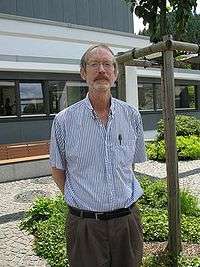Robert MacPherson (mathematician)
| Robert MacPherson | |
|---|---|
|
Robert MacPherson, 2008 | |
| Born |
May 25, 1944 Lakewood, Ohio |
| Nationality | American |
| Fields | Mathematics |
| Institutions |
Massachusetts Institute of Technology Brown University Princeton University |
| Alma mater | Harvard University |
| Doctoral advisor | Raoul Bott |
| Doctoral students |
Eric Babson Mark Goresky Paul Gunnells Julianna Tymoczko Kari Vilonen Zhiwei Yun |
| Notable awards | Heinz Hopf Prize (2009) |
Robert Duncan MacPherson (born May 25, 1944) is an American mathematician at the Institute for Advanced Study and Princeton University. He is best known for the invention of intersection homology with Mark Goresky, whose thesis he directed at Brown University. MacPherson previously taught at Brown University, the University of Paris, and the Massachusetts Institute of Technology. In 1983 he gave a plenary address at the International Congress of Mathematicians in Warsaw.
Educated at Swarthmore College and Harvard University, MacPherson received his Ph.D. from Harvard in 1970. His thesis, written under the direction of Raoul Bott, was entitled Singularities of Maps and Characteristic Classes. Among his many Ph.D students are Kari Vilonen and Mark Goresky.
In 1992 MacPherson was awarded the NAS Award in Mathematics from the National Academy of Sciences.[1] In 2002 he and Goresky were awarded the Leroy P. Steele Prize by the American Mathematical Society, in 2009 he received the Heinz Hopf Prize from ETH Zurich. In 2012 he became a fellow of the American Mathematical Society.[2]
Selected publications
- Goresky, Mark; MacPherson, Robert, La dualité de Poincaré pour les espaces singuliers, C. R. Acad. Sci. Paris Sér. A-B 284 (1977), no. 24, A1549–A1551. MR0440533
- Goresky, Mark; MacPherson, Robert, Intersection homology theory, Topology 19 (1980), no. 2, 135–162. doi:10.1016/0040-9383(80)90003-8 MR0572580
- Goresky, Mark; MacPherson, Robert, Intersection homology. II, Inventiones Mathematicae 72 (1983), no. 1, 77–129. doi:10.1007/BF01389130 MR0696691
References
- ↑ "NAS Award in Mathematics". National Academy of Sciences. Retrieved 13 February 2011.
- ↑ List of Fellows of the American Mathematical Society, retrieved 2013-02-02.
External links
| Wikimedia Commons has media related to Robert MacPherson (mathematician). |
- Robert MacPherson at the Mathematics Genealogy Project
- IAS page, including links to publications and CV
- The work of Robert MacPherson
